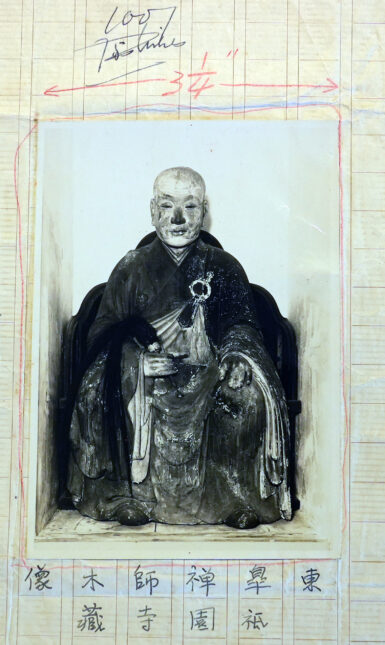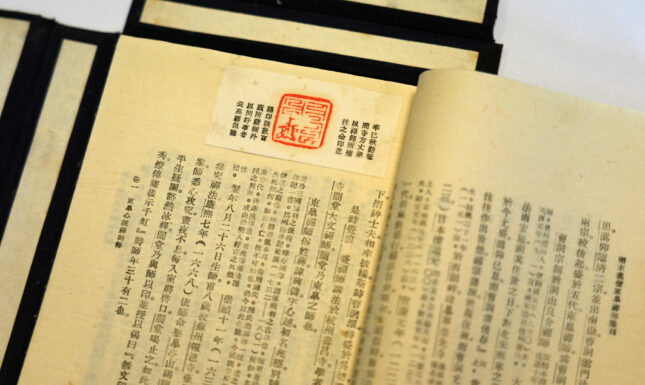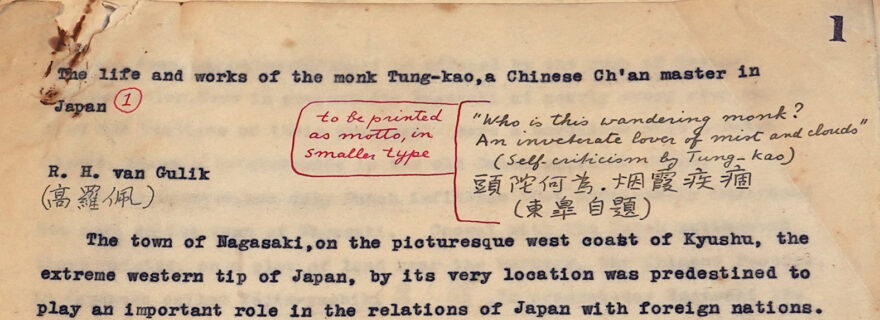Unpublished works of Robert van Gulik: The Collected works of Ch’an Master Tung-kao
On 17 September 1941, during his first posting as Second Secretary at the Royal Netherlands Embassy in Tokyo, Dutch sinologist Robert van Gulik (1910-1967) wrote an article that would meet its readers more than eighty years later.
The paper explores the life and times of Donggao 東皋 (1639-1695, aka Xinyue 心越, Shin’etsu in Japanese), a Chinese monk who left for Japan as the Manchu conqueror overthrew the Ming dynasty. The paper was meant to be published in Tien Hsia Monthly, an English-language sinological magazine published in Shanghai (1935–1937) and Hong Kong (1937–1941).
At the time, Van Gulik worked on a major publication solely devoted to Donggao, studying the monk's calligraphy, paintings, and seals. The publication was about to be printed in 1941, in Japan. However, before the printing started, the Pacific War broke out.
When Robert van Gulik left Japan in July 1942, as part of an exchange of diplomatic personnel between Japan and the allied nations, he could take with him only two of his manuscripts, those of 'Tung-kao' and of 'Pictorial Art'. In 1944, while stationed in Chongqing, the wartime capital of China, Van Gulik published The Ch’an Master Tung-kao, a loyal monk of the end of the Ming dynasty, presenting Donggao’s literary work. However, the publication of Collected Works of the Ch’an Master Tung-kao, as originally planned, never materialized.
The archive donated to Leiden University Libraries in 2022 testifies to this project. It includes many documents that were part of a bigger corpus and were in all probability used by Van Gulik to prepare the Collected Works manuscript. These include four extensive sections featuring photographs of seals, calligraphy, paintings, and wooden boards made by Donggao, each accompanied by handwritten transcriptions.


Among the numerous preserved texts are three forewords in Chinese to chapters in which Van Gulik describes, among others, his search in Japan for Donggao related materials. There is also an index to the seal collection, containing short biographies of persons for whom Donggao had carved seals, an introductory text in English about the finding and editing work by Van Gulik of Donggao’s seals, an unfinished English text titled 'Explanatory notes to the collected works of Tung-Kao', and a Chinese text about the life of Donggao.
Among the documents are also a mounted calligraphy scroll with the characters 東臯心越禅師全集 (Complete Works of the Chan Master Tōkō Shin’etsu), written by Tokugawa Kuniyuki 德川圀順 (1886–1969), a descendant of Donggao’s patron, Tokugawa Mitsukuni 德川光圀 (1628–1700), and two smaller title-slips in calligraphy by Van Gulik and were presumably meant to be used on the book cover: 東臯集 (Donggao Collected Works) and 明代高僧禅師全集 (Complete Works of Chan Master Donggao). There are also a dozen leftover seal imprints, made for Van Gulik by the abbot of the Gion temple in 1941 with a seal carved by Donggao, and kept at this temple.These seal slips, with explanatory text added, were affixed to a page in the biography chapter of each copy of the hardcover edition of the 1944 publication The Ch’an Master Tung-kao, a loyal monk of the end of the Ming dynasty. A letter from the Commercial Press, as well as a contract for the publication of this book, is also part of the archive.


Where did the great interest of Robert van Gulik in this seventeenth-century Chinese Chan monk residing in Japan come from? Perhaps part of the answer lies in his own observation, written in the draft 'Foreword to the Seal Collection Book':
“(…) Long ago the master took his lute, left his place of birth and crossed the seas. Now I too have left a distant land and travelled hither with my lute. Long ago when the master arrived at Mito, [the resident Chinese monk] Zhu Shunshui had already passed away. Now I arrive at this same spot, and the master has likewise passed on to eternity. Alas! It is indeed wondrous that those of identical circumstances and identical interests, though separated by great distances and many generations, can match one another so well, but how difficult is it for them to meet each other at the same time and at the same place so that they can share their affinity! When I think of this I can’t help shedding tears of sadness (…).” (Translation by Piet Rombouts)
_______________
Further reading:
The 1941 article can be read in T’oung-pao (2024, Vol.110, issue 3-4, 434–486): “The Life and Works of the Monk Donggao, a Chinese Chan Master in Japan.”
More information about the donation of the personal archive and collection of Robert van Gulik.


